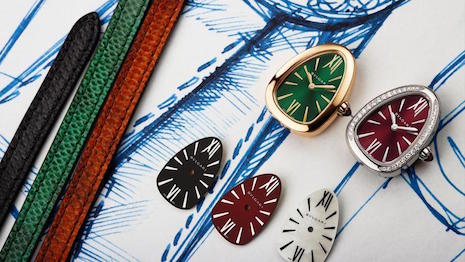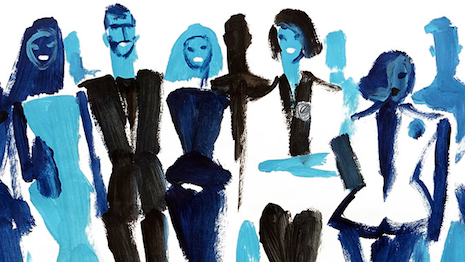NEW YORK – Despite attempts to keep up, there are gaps between what consumers expect from brands and retailers and what is experienced in-store.
Speaking at Luxury Interactive 2017 Oct. 18, four recent graduates from New York’s Fashion Institute of Technology, who are each now working at major beauty and fashion brands, consumers―and especially millennials―said they expect a certain level of personalization and individual treatment from brands. If brands want to keep up with those expectations, they have to be able to adapt to the changing tides of the retail landscape.
"Price, quality and convenience are important, but they are purely mechanical and devoid of emotion and connection," said Grace Gordon, global marketing manager at Estée Lauder.
"Brands are failing to make that emotional impact. There is a deep estrangement between brands and consumers, which we call the consumer gap."
Consumer gap
In today’s landscape, consumers attention is divided more than ever.
When customers have a mobile device with them at all times, it is simultaneously easier to reach them thanks to the constant connection and also more difficult, as they have to compete with all of the other channels vying for consumer attention.
Customers are also more informed than ever before and are less tolerant of mistakes and brands that do not meet their high standards.
In a panel consisting of Ms. Gordon, Unilever’s Pragati Ruia, Estée Lauder’s Crystal Sai and L’Oreal’s Morgan Hagney, the four speakers emphasized that this gap can partially be attributed to brands not living up to their purpose.

Media companies such as Condé Nast have begun to adapt. Image credit: Epicurious
"Our first recommendation of brand actualization focuses on purpose," Estée Lauder's Ms. Sai said. "Why does your brand exist?
"Ninety percent of executives understand their purpose but only 40 percent use their purpose when formulating strategy. It’s easy to lose sight of this when profit margin is paramount."
There are three non-negotiables for millennials in today’s market: price, quality and convenience. The onus is on brands to provide these three things in equal measures to capture that deckle young audience who have thousands of other things they could be paying attention to if a brand does not capture their attention.
"Retailers are losing the competition of life," L'Oreal's Ms. Hagney said. "In a survey of consumers, they’d rather wash dishes than visit a retail store.
"Fifty-seven percent of consumers want stores to serve a higher function beyond selling product."
Branded communities
The lack of appeal to millennials is dangerous for brands for obvious reasons, but some areas of the luxury world have even more of a fire under them to begin engaging young people.
The global timepiece market will face looming problems of sustainability and interest going forward, as younger generations are far less likely to wear a watch daily compared to older consumer segments, according to findings from The NPD Group.
Less than half of all consumers in the United States wear a watch every single day, according to The NPD Group's latest report on the global watch industry. But the majority of those watch wearers are baby boomers, while their younger counterparts who will eventually supplant them in terms of numbers are far less likely to wear a watch ever due to the prevalence of smartphones making portable time-telling unnecessary (see story).

Watchmakers are embracing digital tools. Image credit: Bulgari
Similarly, media conglomerate Condé Nast is putting additional stock in digital content hubs with the launch of title offshoots meant to accompany primary print publications.
Condé Nast has recently ramped up its digital properties to cull millennial readership and to attract advertisers that appeal to the next generation of readers. The media group’s millennial-centric developments includes the “Next Gen” campaign and digital companions for titles such as Architectural Digest, Golf Digest and Bon Appetit magazines (see story).
One of the ways brands can continue to capture millennial attention is to create "branded communities," places that align with millennials' values and treat them as individuals with their own interests outside of the brands they consume.
"Community is the greatest force that draws and binds people who share fundamental values," Unilever's Ms. Ruia said, "Branded communities can drive eight times more traffic than other channels.
"Reebok made a comeback by partnering with Crossfit. They now have 11 consecutive quarters of growth."
{"ct":"RWUdGPuq8LPsZFLz4ET3+D1qdgdVGIX9EALLAecRr9CkWOaDNmjpf5Q4Fxpi\/fWI37aA6D4f39rgD9q+me2NSdhpyk\/AaTy17vdgJm7pBeSKJeg7pJmg2WDUVSA8B9qTvuSudCa5TX2aRryk5r50II8A5xLwBvcR8llJ\/egqjFugJm3GlmlFK2FfoV4TegOxLVwwIrnGwH4PhnPG8F0UGDCLvq6l0Q4U\/hKKDkLRJXh14\/T1YYCEzhc5QRyA+MP7v7+ABFBIxTsCuQUtHqqDS5p0iir4fzVex98SdnoQwFAnL9kH3UWXRW1ZIFCkIRR+Mhe1nP7BFHxblqfbbFbFUqy39mFvIPzBEirbw5PoQ2N1l9amApD\/K83\/pnqdj64NdF2YGdtKA23zcEOpistH83IabJXKFNBBxP3QvXJHQSHYtEXINxSVCbkWG7faxF39MuhPCrrBDWrS0nSYd2I4hXDZEC+ocUko6jkBZY16PF43DdS1faQ8XJcRm4UWMJqeCqajSOMmyNorjMtab1+fEMDWtUwztT\/5lz4t3zH02s2s0X+Z\/6Av7V4k63M5R2MSBuUoVooLYQyQHVYe3GHApZH2KCemrhKoEZh3iw2hMn0bIXStXj19Foj9ARwxB5EnQVen0ZwT73qy9\/rbMz7JelEckkvg0ehw1x7urGA\/Z2K3h9n5zrGcQhQh8gSFv766NgKWA5GCh9wjB7VFiGp39uIt2XsPWKsgx821r+okEDoVF9g3dEwt1bJ2pZR+WKijqEuA8WjHOrWFyGlHkU6y6LN54eARLe6P9StBjT4CvMm1TtoVk2wPv6lHjQCnnghhHPBh42bxHnbHkwEQik2uCDH8WeTtEdiVH1gKlTjK5hZoWaSrUVATPMwrb5OT0nptPM\/aV4Xmt53HbYyovbtEFrwDNrAKGtrZnQh1j5fKo3w9inusxNodBEkQJKbOewx8vLjjq4X6H6fiqcs6zA1e4HWk8wneGtnQRS7PbXA0jir1AdrZq++TX9w1epHQc\/I9Nz0WLQqiul0NLIP1qQm3P+ALMWXyXZPdKNLNj7NWGP6tu11\/Y+R+J1\/U4ILX70rP2YlTSLfBagqjOFLL+MkeoSjx1oTxhwKOZYQQkMEB0+2gu62+4AtH8RBhrKpi28ytnwpdUQp7keZ\/9aQyhUTx+6PeQ9yi1cWSzrLYo\/k92bpxXe1Sd11b9CMahB7ZV82QtQLwi9GcvnsL+KNGyiLuA0cVJ2tM785Wp2mQu\/Ux2oYi3ERUMg9foxCKMKUFJ2fWXOd3lIv2GwCSo5oo7vqEo7bhi+yYsypWtJQ7GWTS4Y6eafW\/SlcHnQfmQVe\/r5wusTPkWU3PwmCgkNgbiOBcuRISuEe2rUB+7iSUVJIgQI2pNTrstqdR+YEw6GfqW8+McIJolozOsdiksrVFRS1YQ5+ssiebb9JQCgu\/ENeJsmJ3nQ9wqOn4yfAV8malx94GpHVUaxerGwwCFg2cGTxLbbE\/toIpT2tAXbefcS0yAAKKbJNrGEjmhdvDwbEPtssC5Ye2dJc2FxYzIfww4fVgMUIztupUiOQugjuMqxXOLVRlTFwxDVGs7uusMX\/fq0gXGY31ahAju0NPuXrj5fols8VS8DHqxS4gD4QguniRMJ+q4iMnA42ioQ3nNY0X+SrSmXsYkvL35Fir7qmcfVEozNYMSZIN4B4IQyHKa1vTDcBubhliikGnFZSdRJ9EPi2yePYC3Au3uzFu2ScS+RhtSAaMhI4Lt+DA02axZiJf7RHmensnP++E8L+B8mT3y7lRoyCTJtzBj03v4QO6+VGUVGpiIob4JOVFpIUHFHHklbUyVx59H13JohUGiXSgEZ7TxaL3hg22Kt7ktLokXDTWP12GFx9BzWEQN2lQ3TiFMLbegzzzEJZUhnP6NDF449VrEa+\/gD0mVEzXX\/CBhjfxRLI\/PbOP78xQo47Frs+Ovd5OSaFEhecw+dMUB6LU4bygRTS72Fr8mjDOKmXdbO\/wGbFGzJIXN350p+ZuiVk86MHxFJioj3eEUnXDT135JyRmhcdoxaRfpOV1elardW\/2gasisz\/0VaH6aaz9JR\/23GB46WAZxtyZPO\/WKEkM2Sv7\/hWD2ihsNlXKxKOuRT0UuV9A2TsWPPgeFodQbeSdO3AhV2zPIp4GZRIGq\/t1nCqYEXylWdwBtvXXMcZbifxxzal0OPhnBlfh\/XRZ4pqDiHWWO893i9Lq3+CUCnWtEmhzJgDZq2Ns2Osruzh5GxEqflHmWQC41epSZgBoSyVdoNUFTV5MOOAsWDzx6fRuAFSYjAVuQoZ\/2CjSqn0msr4MtW55DGXuXn1udywn0xwWGp\/jPanNyy82Ad2AO3xPALvTmoqNyBPlmFr8YBTguKdeyj3SdofQPJo1IlSvG8NzitFu3CoYMAbkytCrJizo0YfPA8fJ+6MbqlVr6VPKaGmMdJbkJlGOSSmXTcyuRhDnnAgoIDsXxx8jhly6HDtFsYijRzmPOrm4vwql6bjvHZzfIVgehmRq\/LSb5Arrcxk3VyPtu+0LBahmbiWgD4zA59NHV3+ghpTGkBs7A9hZuUsH4oobXARiBcgHjMjqcn17P\/bOndFyIsnmWvcSwyAQjtooQx3Gi+FrvO+D9YLyroDRZ45woBGunRGa0dat6dPmxAiLrwmcD4Y7t6weXAtdyrrIyOeScSxv2+ekYcgq8YSyJhxD1vLuuFsB1cCd1yTc8uoqrLknGpAqb8zjMgVloyakgny5y4sukeOp6lrsEwt6Y3ZvuL9TWT2JJ\/OBr9oLe+HM9Nl2hQfqXfue\/BDDr4UBWKjEoGpHh5qjnOGzoe7V9BO60FAAVuGvvJycR27iiMrkfJayNERpfjyTCfjKCSfmnWA6pSaS+863JTb+Efti74CNHiN4diedYTKUKNj1a6TOR+ZuD6yYUzxNLqv7xIPX3YaK+2KUNewHLbo5pzCqo\/q6J8sVdAzzlKVB0RQ3nFzjjq2E865ysVq5HpSdstzQ6EUw2UAZXGLMTuI5HEX+I1pOC\/YwZ+m4dHD5kDd+tHvbFLU8wvsk9SxjpX720Ha\/z8T\/Kx8mwQje1iAmVGifoBEJ+meV5tBJCp0Nzi1q2CtKmn5p0S2JhyhIBtiFZJzO9ZxATegobNMsXwmyv9H3PVBheRSPzN4JNBuW4I4S62SYissnOK8I672L852mPkmJZ8Ji6\/RAqgaMa7+9STN4D1quXDYw2jOMLMP7r46t2xZh2tKbgcHRCa1wr81EtdFudfexO1FH3wmszCcuLJscoC\/6uoa+cSL2W1sXECg\/Ew\/wyIn1lhW4fqqgV7x3Rud+raqoHQK7pRbjirfzWRTL0\/CqCd9iK2Fpg7+n5Ll+EuRsUIM70CTXwjZZ\/fVVSjmWlD3qet03yxbJlBr+y7ZSTPZ+FdzDPBOJXlAddEC2Vs8RBsvcW47NhA1dPupzz8abOIIoKNw90hLokAWUfdjjxF0XdcW\/qiTs6hBlRBZM9b5RdCWD96d\/w3p5XSghypoZ2lbIMwjJgFOusiaM0FJKgsQGvluIV6rt8GlGsu15B9n2CbsMPbeqq55pn8J9sPT+09Oh0vi812bUe\/hFzdVHQpXnQCv6m9tEnYi61ykwRp6TaR9Nrr2VaZreFqm7fFQ6e64yE0L\/V9LRpvEYMVcH63Khne1BCk52XcJODfrQoX58mdpPJpISouSu+fNHelkTx+OHZKxFoq\/u7HfDYOLUce\/29Y\/D3L7qOIUt8cMKmTQ4Z7I6cZrpP2zy50phFDPoi+X0MtpKogxLFuID2pi9cfv4WXWKP4sAWjmcWYi4VaIfw+YvUEXhsgVvQF6p3qEL3ErUU414Vc6F009y5olwBJWOhcnbzxQXH\/VyuZh0wy5PSORos3qio0zRKj1HCH8sh2Bg4dJ7KuRa4bN9lWQUuXV5OZcKjZxK5SAPMDlEc838U4o8sgo81BQk74ryoF6qJ8BcrfGepq0f7s7STXU69oJtBuTbe17ViU+bTUFLRlX4she4KFThSb\/RbaIB60tQ0h+hcdp5DWMGyhX+5oVXx456n06K1sBQEx3t2hJRHjUlHYbFTeaBPsS\/h5evg1YewjT1B5Mg+atnxbN\/mRckkjivpwlFdh+mkzKMFZJPhgcbbEEKcfF+830TeRPutxsVPkqneOajrLi8c52qVAcS6lWnRBx8XYzb6khb0020N4cKzP0WfHwoe0y55Y0xtZOyaCefV\/RXRfT6q4opbGQjl9CdhpNfBSom0DUSc0Cvb8hYzqXQVjOQlwFzKPzPmoJJ2HvHW0MAwr8RAdSLm\/EEH9uzFj+AfRbtPjeNjadhoNib8RA6ZBoUbCSWVs4sPQEkobNLVGX4YINCyIL0LPFu4yFnVyGkKeXkaRbcL5NZw9gvgP+0Z\/J\/iPqQX4pOAw8ix7YJ7OhYQ\/R9\/8K15BxqpsKdcP1JshExZ14GsvrNu+w\/4ad1PsP54pkx2U0loA6lCwSlzWjEIRhL9Tx7l2Yrl\/J6jVajsENefcjD9LU8WvPD+4g2eN1ZOOgI5tXkaYs+4XPZ9\/E+6aWaO3HdxkjrLolQjC2rjkgbhMmIx+WkudcTw43nkdUH3ulc2q4DPntDbDpgk0cZN3MeB3foX6HA\/vR5RsdHmcHzo4i2n7Bf3\/d7G2HTiC3ZJUvbsqr\/itUyknrtOGobUQDS5GV0RvuaXRznPNW1ixHXAgh3g+n\/ZWDRausyfYvRGdYe9Y4xbpvM1qxe2dCDEvYD2Zh1dCz15qdl6H3SLOEdIYul5QA0bA4LuLJ036P3kt3RPBV0DUPfrMrhd9cjaoGuRV9Xc0D7RnplhOpeeEvjg2OWioFjrZORBPPvfot0BjPtrSsIvo7cPfbEmY5TWa0xXcM8+4QAN2ZqjjSIm58uFirb+P\/yEgfYe3D3hMHYvwbvpH+q+5m7dPzStzshkvoFfDuiGIMP802+JLTvgyNj3UeadQOiFQJTzCMnr4S7Rdvbb2Fc+LzdfioRkQ\/h9DjO5D0pNYShZiInksuFv3C7irluRhc3SvX7JeWDMkENAaArPZeioNlK\/Y+erloKeNJ0bCCkgxFGdFsJCEc+5koXvraPgAO5XWi8Z1Wcs7pNw2E2S47QYmQIKHMPgWLTLWkMAr\/NHG7ZDY9lOkmDr4vO9M94CuScfPAp5Nps0dkFRIUMTPLrnx4xX6q6mpWYMjsHTkLA4QEsCQ5SW6bclABMT1OIZzSfeD7avkeio4HUqOCTNYJG5884YS0mfe+jhh\/M4NvYbazbJKviOKNKoKqkSzA\/H26yYyXZiMP+4vntPfL3P7jRcFzTqAe20jd2bnigPN4KOgiCaHDzK53609WtR7G4J+FcpAWqnSFFKV+e7MaU5Eu7u7CHhxvSa1gY\/7L9jcQxguLSUkpEXmtA2UxDn6zRWWfX9GEvrnU29O+FG\/vCwZECRpt7MY7L2jw5RP1e8OCcW8nInr5MQuwx6JD33\/uh0TgFNTRCh807tvz6DavVyOtDqKVbvFiOffbI8WQ61W9hvlu8\/CcQQpInhPV6Hx4gagpIYN1se2Rag6SJyA0QYFCV6dEVf6D3\/7VkN6nH6zhL\/XNfz13+uK9ESK\/pInzhXdKkpiRpfj\/kkGePlTJo9PeOeL5XvBMGNRCpwUHE5ON4dUI0P\/ae6RHjymagELKgX\/h3e\/XbMYlaKcyhtic4Hlabyv6D8PNvbcZfPzspQhxxCW5+3kqfkLBpeq3XOJSDGk01LOh3+\/XCR90vaJjXXwQbpgP60QYUDXlZNMlw6mFKy2f0FyhbsavknJrLpyBQm1n9lfVwwabvojl7NF+prqe205D4HxxmOndx9+cDUawh4N3dDLcNT+On1n0wfRXK4Ic6BiFVfxEEEKbkWIzmUF0p96PX7RBby+PBjNZYxs8XIMgam8ajJp8uVF9c3JbsNl98f5JzpwCoBuk4gg0uMzzNDmXHrZzdwhV5NChIbevHUXibijA6InLV8DK1SBEvG5sLr04NxMuXIXzJpM1cyOSPclo0eQzxGIsWsezLplielvos6oIIlE1I\/\/GnLAYu6LJUVyS4vc+UdFOZLa\/Ww1+hP2nN9NdvgyHnfwPZxeOskkCJOi+LdJXPVglHIEK8qJksAI+85SU3uzSNveV3HEy\/7MmdwKukfoWFQlBp4+6bHMtSGLp7nYwMZ2RN4jHrNvm+MVDGpl3AhX6Nw\/E7eQtv8pTVi\/Oz7RLym65eLv6ok0R2If7a1NQeBkVWZ9+YfYx\/Fx4VyX9vnHBx09MfwtBTQO\/4GqznGqK1Rc96Xg4+MPZ7C6M8JyOHEo3u\/S2xSp8gS71UgpT+T52YFY0QN87LcjCAQsNCUaLQHrXXgYdZIKYz1mkvFKprwONGb4k3hPUr56eYiqO7Huh8SpTNHmN5eCwKxeGbDASGWeeBAV4dPDojYFMz47AqPPIsL3mPzarx+xF0RWYa\/jOYyDYNPUXDIvtSvP0tYpyAFrZBJRISZkg3S9YBXKY88VczMjemdVvNGKN2VjXstPVbKNpP0y9QWT0sh8qJvv5VE1sxvO62iirbi9EMOL8f1XLM8KQ3NmOwZ\/ywF3f4ml8aFS3zkie0hhigp1X3Oq2NZYI1Jfu\/tpGhxrHFcR6\/zn6BGbbbQAdwePLluq0omOFvOXoPiK8a8YtgKyG9dAohgEkMhZlCR63fanlzQdRvEZchX+d3jWdU3tFoRU07tuVWJTc2p4CFOcoBdxgejM9YYtwSN632WuqzQBroFRWLVNswZCDJNYZshyJmq5nQnfQkiU4L1unHK20wQYXM9lEP56xsVWhMEqvBfGGpZcamaCE1MO4DizEe7jLtsT7NmaY1MyJe4MyX2KyYdA8mEMb40oYebfG8IcBbrTizNvu+kxI3HyqHLE6cDI0S\/fGsHaOfKWRr0onBsXzvtXkUAX64VjQ9IkDmmOSKImLkht0CixIPYCO0BICFH\/CCi4EhfbiP\/AEJKN1yAj48DJSPmTUg9fD2OzpIQZQOHUchmBOck0LqtTtAQRzklmWYQr\/lElOp8NDsH9stFANa3eO3EwpfprudmK9O9WWVY5xuqVZILKFcOz4FujKHrlwmfUBGxNpXiOJ4igZEZLPuPwJq\/IXqsp8JZEqFOzKoK12VNd3JGVrdGpj7TuUHSTOCK7SzM4fbM8hZi3nx3XWOfiJXgc5nisthLXjfB82+ol6DP9FLBCX46cQkMFCnOyCODt8Cx2tRQAWIp+TQ\/+kiOrKh5NssT2ZF4C4Q9qt\/WgIgskoJGJfCHb3PQ+ZwoR2E3k0dWd8ajleoBnRmn+Dn13GMkgMBYY1v51Sa+mgIDcLXF4sE5iefJ\/wYllg4f3z12S06oCF0NOk1D33\/cR38xPqlCT9Cp8CVlnLow\/\/ql0LmcQvdOJ6XX5PR9cfWUSnbdPHSJ9DY9IwvMWeNOUyKkV6OMalCoklGzJyAxN1dcTV6eQiYBFcKS+WuvHkZ7IKCNPo8rg6ShLO\/J2yGfIsPuHHz4GMhFlh8rKw7GnDCiEBR2uKpkjb3JF+Y9IpmC+id21Ul8deNkdVTSyzEwh2ujmgedkKJxRxJL674ttzcVDiM0Y5jvqtkVlOBFYToRU9e0kGJkS24nBnmfdarEfqOeWm9jyId+eHJg5Pd0++q+xEBQiPiWQ\/HqftTjYddgUa4ZUSPSAYtjc6oP9\/CDZiBpi4s\/OpxUIh+5N7g3YMwHwNAJKY0LHjwPTXUhHcHFPNSOyVC+AyX\/RJroEZDD+fzjmTkABP9LdUCNvIuRzw5ghh54fuDiV5gnBTzngD4gq61dQ4RcmFcwwp6tz1aCAu9tyYZe8c8X\/yNLdglI51tM1iGA0xOKkaeWCF1CLZg3Tj9Jx9TSmhmIKlVLCTz50c7exxzvq2mJ2lq2NesgCIpNUg6pb46EE+ViX3CSSsRl393sr+tB5GITkrVzEmhXKhoup1M5D4e6eCpDW8bUaogB0tQ2pQ1uXNMI31\/JdafdMG+LHcmlsOw4MrPwu0zLawux2RjJH24j9P+BtinkE1D4zlxSp0iz5b2NED8pZEBkNVm68vvUOJ0j4YOFwB5nhsWovjgWS3SVImJnSOfa8y+KTFekvL2onSG\/MrmbafpPwAEnucq\/2EdQPVXGLUW6rKRFLJqUXsF5\/wx8PK2uOLjhASJbAiZNuK2CPnbA6bxHy6PTruDBUHhoN7tDSvCH8U2E4psIIWYcpMojWIXpu4FgKNpuDLsUbUJ9qxUaSiUDzEId17WX9XdX8qUeIjKNNGtGQLQXVnQEz5Tb3oj3IfbpSIUSdtpEFSZZNjhr4s2cOcg\/ugaAec3ceE60DTpcldfCTz8IveJwwx\/\/p+pWJX1PaqoklLkcLbaCNclI8WVZa\/5c72WEUVRbiVhGqBzVBpWy2KvDxt5TS13JGsbdAQI0PoANFzlU7r0Y6JM240SEEHpX7pqREwct\/GytcDxK9TtO72fY1i+uVoLMktbCIeudQCnamllFsuycjs6zBtMdrA=","iv":"470f892b2ea6a35ffee5a48d23128440","s":"2edeba3dbe225abe"}

 Branded communities and treating millennials as individuals are key tools. Image credit: Estée Lauder Companies
Branded communities and treating millennials as individuals are key tools. Image credit: Estée Lauder Companies